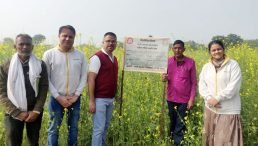Udaipur : India occupies a prominent position in the oilseeds across the world. India is the 4th largest oil seed producing economy in the world after USA, China and Brazil. The rapeseed-mustard is the second most important oilseed crop, which is largely grown in Rajasthan, Madhya Pradesh, Haryana, Uttar Pradesh, West Bengal and Gujarat with an estimated share of about 93% in total production in the country. The rapeseed-mustard accounts for nearly one third of edible oil produced through primary sources making it country’s key edible oilseed crop. The productivity of Rapeseed-mustard in India is the lowest among the major rapeseed-mustard growing countries. The gap in yield is because of lack of knowledge and awarness about the improved practices/technologies, least use of improved varieties, higher seed rate, lack of seed treatment, inadequate and imbalanced fertilizer use, lack of use of appropriate plant protection measures against pest and diseases, poor market connection etc.
The Nation’s dependency over 70%on imported edible oil is a matter of concern for food security and to address this challenge, India needs to critically look into the ways and means to increase productivity of important oilseeds crops.
Mustard -hope for the future
To address this challenge, The Solvent Extractors’ Association of India together with Solidaridad is implementing the Mission Mustard Model Farms Project, since 2019, in Rajasthan; one of the largest mustard producers in India with an ambitious target of increasing the production of rapeseed-mustard by 200 lakh tons by 2025. Under the project, in the Rabi season 2020-21, 200 model farms were set-up to demonstrate effective farming techniques to around 10000 farmers in the four Districts of Rajasthan i. e. Bundi, Kota, Baran and Tonk. The farmers are supported through extension and trainings on scientifically proven technologies, access to improved variety seeds and crop management practices for better yield and income.
Mustard Productivity – improve livelihood of Farmers
To assess the outcome of this project, an independent study was undertaken by one of the renowned research agency MART. It has highlighted the model farms project has been highly effective while supporting rapeseed-mustard farmers to produce more with adoption of cutting-edge technologies and agronomic practices. The study inferred that the average productivity of the Model Farms is about 50% higher than the productivity of the control group. The farmers are benefitted through cost-savings and better yield coupled with lower production losses. Thereby, the mission significantly contributes towards the better livelihood of farmers while facilitating a bold step towards the Atma-nirbhar Bharat.
In a major breakthrough in rapeseed-mustard farming, the project demonstrated that productivity can be increased upto 50% by changing in the production practices, techniques and improved seed quality and varieties. In previous season, the model farms have demonstrated a 23% higher yield than the control farmers. This seasons’ results demonstrate a significant improvement in yields.
The district-wise variation for Model Farms vis-à-vis Control Farms is shown below:
Model Vs. Control
| District | Avg. Model Productivity (KG/Ha) | Avg. Control Productivity (KG/Ha) | % Increase / Decrease of Model over Control |
| Bundi | 2759.90 | 1750 | +57.71% |
| Tonk | 2517.17 | 1466.25 | +71.67% |
| Kota & Baran | 2968.75 | 2531.25 | +17.28% |
| 2728.59 | 1915.83 | +48.89% |
According to the MART study, the average productivity of Model Farms is 2728.59 KG/ha for the year 2020-21, as against 1915.83 KG/ha of the Control group. Therefore, it is inferred that the average productivity of the Model Farms is 48.89% higher than the productivity of the Control group.
The productivity of the Model farmers in 2020-21 was measured against their productivity without project’s support in the previous year. The average productivity without support in 2019-20 was measured at 2000 KG/ha, while that for 2020-21 was 2728 KG/ha, which is an increase of 36.40% over previous year due to Solidaridad’s intervention.
Higher Productivity- encourage shift up of Area
The study conducted by MART highlights a 75.2% per hectare surplus from mustard crop as compared to 37.8% surplus on wheat cultivation. This will encourage the shift towards mustard crop particularly in Punjab, Haryana and other states by demonstrating the financial viability of Mustard over conventional crop like rice, wheat and sugarcane. Says Mr Atul Chaturvedi, President, The Solvent Extractors’ Association of India
“The Mustard Mission provides an important opportunity for improvement in production and productivity of oilseeds crops and thus, improving the lives of the farming family. It allows farmers’ access to cutting-edge technologies and agronomic practices to overcome production constraints as well as access to better infrastructure facilities and profitable markets. Said Dr Suresh Motwani, General Manager, Veg Oils, Solidaridad Network Asia”
We plan to establish more then 500 model farms in ensuing Rabi season connecting over 25,000 Mustard farmers in Rajasthan and Madhya Pradesh to demonstrate the way forward towards self-sufficiency in Edible oil. Says Dr. B.V. Mehta, Executive Director of The Solvent Extractors’ Association of India.



